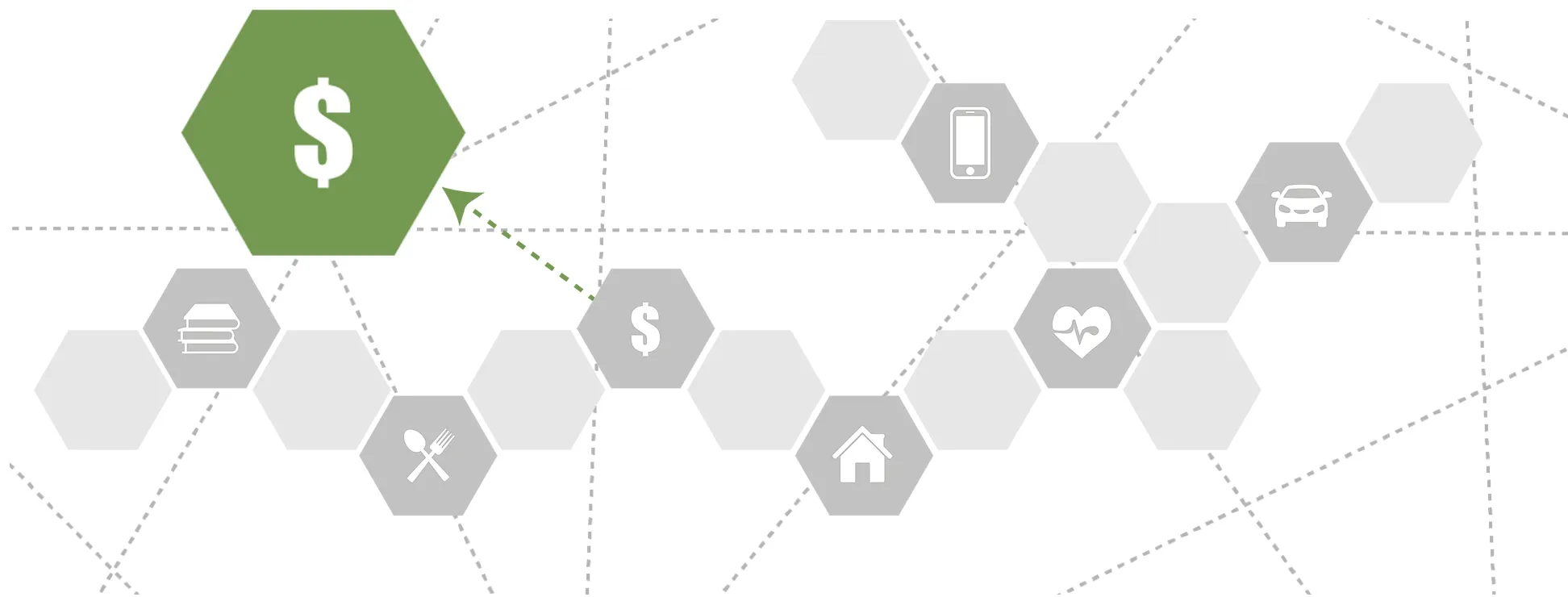
|
Housingclick to view |

|
Health Careclick to view |

|
Child Care and Educationclick to view |

|
Technologyclick to view |

|
Foodclick to view |

|
Taxesclick to view |

|
Transportationclick to view |
||
Impact on ALICE
What do families do when they don't have enough money to pay their taxes?
Taxes, whether they are deducted from a worker’s paycheck, or paid quarterly (for self-employed workers), are a burden for ALICE families. For most workers, payroll taxes are automatically deducted from their paychecks; many have income taxes deducted regularly as well. However, many families are left with an income tax payment due each April. With low income, little or no savings, and a range of family and work responsibilities, families have limited choices for paying these taxes. Different ALICE families may try to:
Seek tax credits
Tax credits make a difference for many ALICE and poverty-level households. The most common credits, the EITC and the Child Tax Credit (CTC), provide relief primarily for low-income earners with children. These credits encourage work, and they supplement the wages of low-paid workers. For taxpayers with the lowest incomes, the two credits together more than offset income and payroll taxes to raise living standards. In 2015, the two credits together lifted 9.8 million people out of poverty (including 5.1 million children), and improved financial security for an additional 22 million.8
Tax credits make a difference for many ALICE and poverty-level households. The most common credits, the EITC and the Child Tax Credit (CTC), provide relief primarily for low-income earners with children. These credits encourage work, and they supplement the wages of low-paid workers. For taxpayers with the lowest incomes, the two credits together more than offset income and payroll taxes to raise living standards. In 2015, the two credits together lifted 9.8 million people out of poverty (including 5.1 million children), and improved financial security for an additional 22 million.8
EITC and ALICE
Many ALICE families, especially those without children, earn too much to be eligible for tax credits. In today’s society, families with children under the age of 18 make up only one-third of households in most states. For taxpayers eligible for the EITC with no qualifying children, the credit does little to offset income and payroll taxes. As a result, these taxpayers often pay a higher rate of taxes than wealthier households.9
EITC and ALICE
Many ALICE families, especially those without children, earn too much to be eligible for tax credits. In today’s society, families with children under the age of 18 make up only one-third of households in most states. For taxpayers eligible for the EITC with no qualifying children, the credit does little to offset income and payroll taxes. As a result, these taxpayers often pay a higher rate of taxes than wealthier households.9
For a family with two children, the income limit for the EITC was $50,597 with a maximum credit of $5,616 in 2017. But for a single adult with no children, the income limit was $15,051, with a maximum credit of $520.10
Nationwide in 2017, the average EITC amount received by a total of 37 million families was $2,445, ranging from $1,957 in Vermont to $2,892 in Mississippi.11 These amounts are significantly less than tax credits and deductions received by higher-income households (such as credits for capital losses and mortgage interest credits). For the CTC—which is more widely available across income groups—it is estimated that 91 percent of families with children received an average CTC of $2,420 in 2018.12
The refunds are a major boost for these families and spent immediately. Many are waiting for the refunds to pay down debt or for emergency expenses. According to a recent survey, even a one-week delay in the refund would "somewhat negatively" affect one-third of respondents’ household finances. And 15 percent of families spent at least 15 percent of their refund at retail stores and restaurants within two weeks of receipt.13
Because the EITC makes one relatively large payment per year, it provides low-income households with a rare opportunity to make important big-ticket purchases. EITC recipients are most likely to purchase a vehicle, more so than electronics or even children’s clothing.14
The benefit of the credit is mitigated if low-income taxpayers use a paid preparer, which 55 percent of households with income under $30,000 did in 2010. Except in a handful of states, paid preparers are not regulated, and there is wide variation in their accuracy and fees. While there are well-trained volunteer tax preparers in most states, they prepared less than 2 percent of returns.15

Minimize Taxes
The rise of the gig economy means many more opportunities to earn income. While working “off-the-books” is not new, it has become much more common in the last decade with the advent of on-demand apps such as Lyft, Etsy, and Airbnb. For part-time or one-off jobs, workers may not understand their tax responsibilities. In addition, there are millions of service providers and sellers working and earning income in the “shadow economy,” with income that is not readily identifiable by government tax authorities. In 2016, the U.S. shadow economy was valued at more than $1.4 trillion.19
Even on-the-books freelance and contract workers, whose numbers are also growing, may not be aware of their tax responsibilities or follow the current tax forms, because the classifications were developed before many of these jobs existed. While income and payroll taxes are automatically taken out of a salaried worker’s paycheck, contract and freelance workers are left to make tax payments themselves, typically as estimated quarterly taxes. These workers may delay or decide against paying quarterly taxes in order to keep more of their income in the short term.20
Misreported individual business income and self-employment taxes make up more than 42 percent ($194 billion per year) of taxes that are unpaid or paid late.21
The rise of the gig economy means many more opportunities to earn income. While working “off-the-books” is not new, it has become much more common in the last decade with the advent of on-demand apps such as Lyft, Etsy, and Airbnb. For part-time or one-off jobs, workers may not understand their tax responsibilities. In addition, there are millions of service providers and sellers working and earning income in the “shadow economy,” with income that is not readily identifiable by government tax authorities. In 2016, the U.S. shadow economy was valued at more than $1.4 trillion.19
Even on-the-books freelance and contract workers, whose numbers are also growing, may not be aware of their tax responsibilities or follow the current tax forms, because the classifications were developed before many of these jobs existed. While income and payroll taxes are automatically taken out of a salaried worker’s paycheck, contract and freelance workers are left to make tax payments themselves, typically as estimated quarterly taxes. These workers may delay or decide against paying quarterly taxes in order to keep more of their income in the short term.20
Misreported individual business income and self-employment taxes make up more than 42 percent ($194 billion per year) of taxes that are unpaid or paid late.21

Sources
8
Horton, E. (2016, October 19). EITC, CTC together lifted 9.8 million out of poverty in 2015. Center on Budget and Policy Priorities. Retrieved from https://www.cbpp.org/blog/eitc-ctc-together-lifted-98-million-out-of-poverty-in-2015
Marr, C., Huang, C., Sherman, A., & DeBot, B. (2015). CBPP-EITC and Child Tax Credit promote work, reduce poverty, and support children’s development, research finds. Center on Budget and Policy Priorities. Retrieved from https://www.cbpp.org/research/federal-tax/eitc-and-child-tax-credit-promote-work-reduce-poverty-and-support-childrens
Center on Budget and Policy Priorities. (2016). Policy basics: The Earned Income Tax Credit. Retrieved from https://www.cbpp.org/research/federal-tax/policy-basics-the-earned-income-tax-credit
9
Horton, E. (2016, October 19). EITC, CTC together lifted 9.8 million out of poverty in 2015. Center on Budget and Policy Priorities. Retrieved from https://www.cbpp.org/blog/eitc-ctc-together-lifted-98-million-out-of-poverty-in-2015
Marr, C., Huang, C., Sherman, A., & DeBot, B. (2015). CBPP-EITC and Child Tax Credit promote work, reduce poverty, and support children’s development, research finds. Center on Budget and Policy Priorities. Retrieved from https://www.cbpp.org/research/federal-tax/eitc-and-child-tax-credit-promote-work-reduce-poverty-and-support-childrens
Center on Budget and Policy Priorities. (2016). Policy basics: The Earned Income Tax Credit. Retrieved from https://www.cbpp.org/research/federal-tax/policy-basics-the-earned-income-tax-credit
Falk, G., & Crandall-Hollick, M. L. (2018, April 18). The Earned Income Tax Credit (EITC): An overview. Congressional Research Service. Retrieved from https://fas.org/sgp/crs/misc/R43805.pdf
10
Internal Revenue Service. (2017). EITC income limits, maximum credit amounts and tax law updates. Retrieved from https://www.irs.gov/credits-deductions/individuals/earned-income-tax-credit/eitc-income-limits-maximum-credit-amounts-1-year
11
Internal Revenue Service. (2017). Statistics for 2017 tax returns with EITC. Retrieved from https://www.eitc.irs.gov/eitc-central/statistics-for-tax-returns-with-eitc/statistics-for-2017-tax-returns-with-eitc
12
Tax Policy Center, Urban Institute and Brookings Institution. (2019). Briefing book: What is the child tax credit? Retrieved from https://www.taxpolicycenter.org/briefing-book/what-child-tax-credit
13
Maag, E., Roll, S., & Oliphant, J. (2016, December). Delaying tax refunds for Earned Income Tax Credit and Additional Child Tax Credit claimants. Tax Policy Center. Retrieved from: http://www.urban.org/sites/default/files/publication/86336/2001018-delaying-tax-refunds-for-earned-income-tax-credit-and-additional-child-tax-credit-claimants_0.pdf
Mendenhall, R., Edin, K., Crowley, S., Sykes, J., Tach, L., Kriz, K., & Kling, J. R. (2010, June). The role of Earned Income Tax Credit in the budgets of low-income families. National Poverty Center. Retrieved from http://npc.umich.edu/publications/u/working_paper10-05.pdf
Aladangady, A., Aron-Dine, S., Cashin, D., Dunn, W., Feiveson, L., Lengermann, P., Richard, K., & Sahm, C. (2018, June 21). High-frequency spending responses to the Earned Income Tax Credit. Retrieved from https://www.federalreserve.gov/econres/notes/feds-notes/high-frequency-spending-responses-to-the-earned-income-tax-credit-20180621.htm
14
Goodman-Bacon, A., & McGranahan, L. (2008). How do EITC recipients spend their refunds? Federal Reserve Bank of Chicago. Economic Perspectives, 32(2). Retrieved from https://www.chicagofed.org/publications/economic-perspectives/2008/2qtr2008-part2-goodman-etal
15
Tax Policy Center, Urban Institute and Brookings Institution. (2019). Briefing book: Why do low-income families use tax preparers? Retrieved from https://www.taxpolicycenter.org/briefing-book/why-do-low-income-families-use-tax-preparers
Schneller, J. P., Chilton, A. S., & Boehm, J. L. (2012). The Earned Income Tax Credit, low-income workers, and the legal aid community. Columbia Journal of Tax Law, 3(2). Retrieved from https://taxlawjournal.columbia.edu/article/the-earned-income-tax-credit-low-income-workers-and-the-legal-aid-community/
16
Marr, C., Huang, C., Sherman, A., & DeBot, B. (2015). CBPP-EITC and Child Tax Credit promote work, reduce poverty, and support children’s development, research finds. Center on Budget and Policy Priorities. Retrieved from https://www.cbpp.org/research/federal-tax/eitc-and-child-tax-credit-promote-work-reduce-poverty-and-support-childrens
Anderson, A. (2017, April). California should do more to raise awareness of the California Earned Income Tax Credit (CalEITC). California Budget & Policy Center. Retrieved from https://calbudgetcenter.org/resources/california-raise-awareness-california-earned-income-tax-credit-caleitc/
Daminger, A., Hayes, J., Barrows, A., & Wright, J. (2015, May). Poverty interrupted: Applying behavioral science to the context of chronic scarcity. Ideas42. Retrieved from http://www.ideas42.org/wp-content/uploads/2015/05/I42_PovertyWhitePaper_Digital_FINAL-1.pdf
17
Internal Revenue Service, Taxpayer Advocate Service. (2015). 2015 annual report to Congress: Report highlights—Earned Income Tax Credit. Retrieved from https://taxpayeradvocate.irs.gov/reports/2015-annual-report-to-congress/report-highlights/most-serious-problem-EITC
Internal Revenue Service, Taxpayer Advocate Service. (2015). 2015 annual report to Congress, Volume Two: Understanding the Hispanic underserved population. Retrieved from https://taxpayeradvocate.irs.gov/Media/Default/Documents/2015ARC/ARC15_Volume2_4-HispanicUnderserved.pdf
18
Tax Policy Center, Urban Institute and Brookings Institution. (2019). Briefing book: Why do low-income families use tax preparers? Retrieved from https://www.taxpolicycenter.org/briefing-book/why-do-low-income-families-use-tax-preparers
Schneller, J. P., Chilton, A. S., & Boehm, J. L. (2012). The Earned Income Tax Credit, low-income workers, and the legal aid community. Columbia Journal of Tax Law, 3(2). Retrieved from https://taxlawjournal.columbia.edu/article/the-earned-income-tax-credit-low-income-workers-and-the-legal-aid-community/
19
Association of Chartered Certified Accountants. (2017). Emerging from the shadows: The shadow economy to 2025. Retrieved from https://www.accaglobal.com/content/dam/ACCA_Global/Technical/Future/pi-shadow-economy.pdf
Bruckner, C. (2016). Shortchanged: The tax compliance challenges of small business operators driving the on-demand platform economy. American University, Kogod Tax Policy Center. Retrieved from https://www.american.edu/kogod/research/upload/shortchanged.pdf
20
IRS. (n.d.) Independent contractor (self-employed) or employee? Retrieved from https://www.irs.gov/businesses/small-businesses-self-employed/independent-contractor-self-employed-or-employee
IRS. (2019, February 14). Expansion of the gig economy warrants focus on improving self-employment tax compliance. Treasury Inspector General for Tax Administration. Reference Number: 2019-30-016. Retrieved from https://www.treasury.gov/tigta/auditreports/2019reports/201930016fr.pdf
21
Bruckner, C. (2016). Shortchanged: The tax compliance challenges of small business operators driving the on-demand platform economy. American University, Kogod Tax Policy Center. Retrieved from https://www.american.edu/kogod/research/upload/shortchanged.pdf
22
Internal Revenue Service. (2016). Special topics—Civil fraud. Retrieved from https://www.irs.gov/irm/part25/irm_25-001-006
23
Johnson, D. (2016). Safety in the gig economy. Industrial Safety & Hygiene News. Retrieved from http://www.ishn.com/articles/104138-safety-in-the-gig-economy
Strom, S., & Schmitt, M. (2016, June 12). Protecting workers in a patchwork economy. The Century Foundation. Retrieved from https://tcf.org/content/report/protecting-workers-patchworkeconomy/
24
Internal Revenue Service. (2016). Special topics—Civil fraud. Retrieved from https://www.irs.gov/irm/part25/irm_25-001-006
Lorette, K. (2016). Penalties for tax evasion. Houston Chronicle. Retrieved from https://smallbusiness.chron.com/penalties-tax-evasion-4224.html
Lazarony, L. (2016, November 4). Do taxes affect your credit score? Retrieved from Credit.com: https://www.credit.com/taxes/do-taxesaffect-your-credit-score/
Internal Revenue Service. (2016). Internal Revenue Manual: 4.10.6. Penalty considerations. Retrieved from https://www.irs.gov/irm/part4/irm_04-010-006.html

